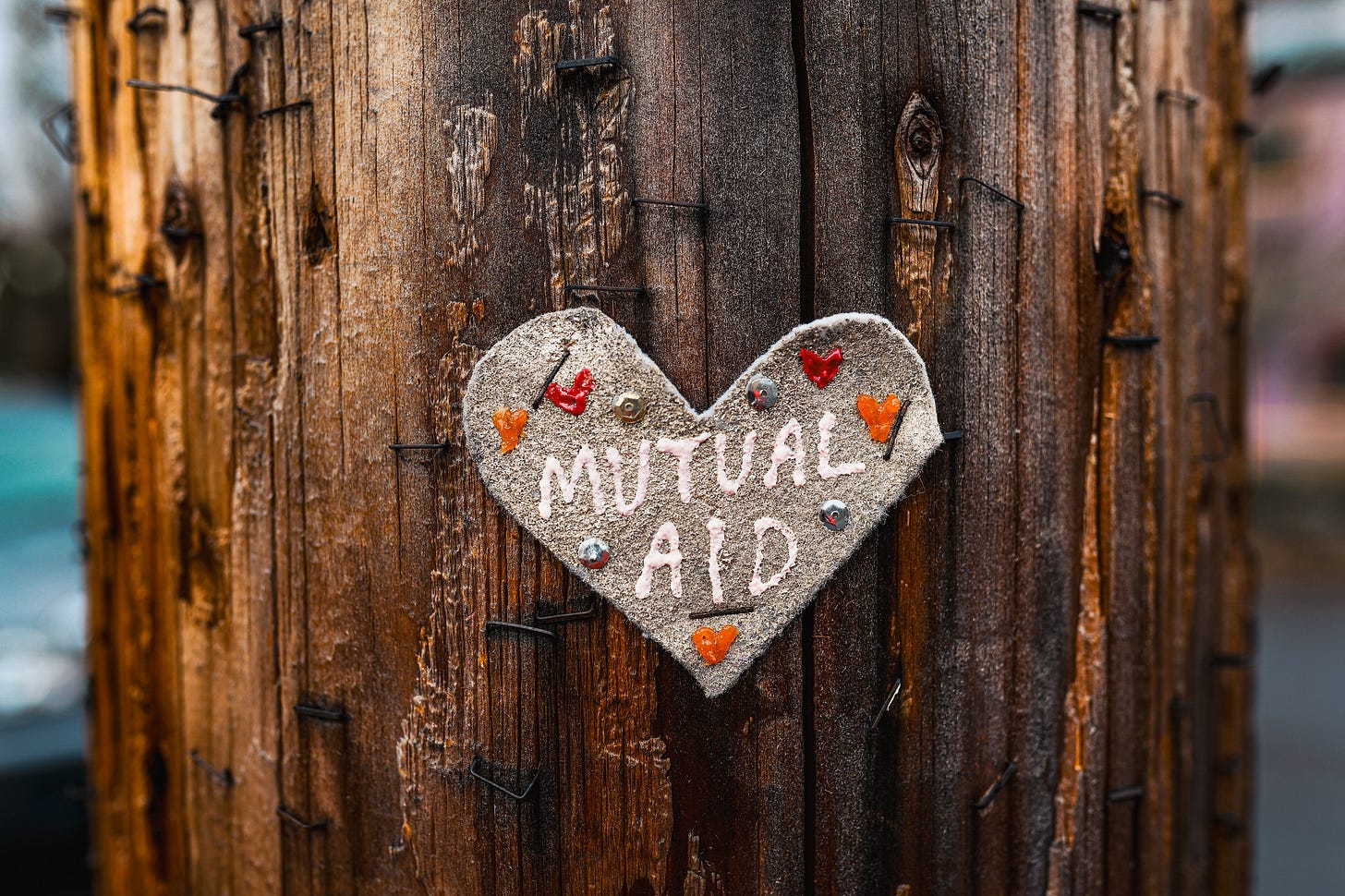Prefigurative Community Building (Part 22)
Mutual Aid Networks: Planting Seeds of Local Care in a Fragmented World

Mutual aid isn’t radical, it’s natural. For every bird that alerts its flock to a predator, every wolf that shares a kill with the pack, every tree that feeds nutrients through mycelial networks to a struggling neighbor, there is a deep and ancient truth: life sustains life. Across species, collaboration has always been more enduring than competition. Mutual aid is the default relation for all living things, including us. It’s how communities survived long before markets and states.
But in a hyper-individualized, atomized world, where care has been outsourced to institutions or commodified into services, the simple act of showing up for each other without expecting anything in return feels revolutionary. It shouldn’t. When we engage in mutual aid, not out of pity or charity, but out of shared vulnerability, we don't just stitch torn social fabrics. We realign with something inside ourselves. A deep-seated need to enact care, to matter to others, to be part of something larger than our own survival.
Mutual aid networks aren’t emergency stopgaps. They’re the blueprints for a different kind of world, one based on Power With, not Power Over. Here's how to start one where you live.
Step-by-Step Guide to Starting a Mutual Aid Network (Power With Approach)
Step 1: Find Your Core Circle
Mutual aid doesn’t start with an organization. It starts with people. Reach out to neighbors, friends, and local activists, really anyone you trust. Keep it small at first (3–7 people). Emphasize shared responsibility, not roles of leadership.
Resource: Mutual Aid 101 Guide – Big Door Brigade
Step 2: Identify Needs and Offers
Rather than deciding what people need, ask. Use simple tools: surveys, community message boards, door-knocking, or local group chats. At the same time, map out what your group and neighbors can offer, such as time, food, transportation, or skills.
Resource: The People’s Solidarity Hub Mutual Aid Toolkit (PDF)
Step 3: Choose a Communication System
Pick one or two communication channels that are accessible. That might mean a Signal thread, a shared Google Doc, a bulletin board, or printed flyers. Don’t default to tech. Prioritize accessibility over efficiency.
Resource: CrimethInc’s Mutual Aid Infrastructure Guide
Step 4: Make the First Connections
Organize a small mutual aid exchange. Deliver groceries. Share home-cooked meals. Offer child care or ride shares. Keep it light and grounded in care. Avoid application forms or criteria, trust and openness are the core currency.
Resource: Mutual Aid Meditations – Dean Spade
Step 5: Create Non-Hierarchical Structures
Use consensus or sociocratic decision-making. Rotate tasks. Document your process openly. Make it easy for others to join without requiring credentials. Keep meetings optional, transparent, and inclusive.
Resource: Seeds for Change Consensus Toolkit
Step 6: Expand Through Trust, Not Growth
Avoid the pressure to become an NGO. Don’t apply for big grants unless you’re ready for bureaucracy. Let the network grow laterally by supporting others to start their own circles. Share tools, not ownership.
Resource: Beautiful Trouble’s Mutual Aid Page
Step 7: Document, Reflect, Evolve
What’s working? What’s not? Host reflection circles. Let new members bring new methods. Share your successes and mistakes online, zine-style or via local newsletters, to help others learn without centralizing your work.
Resource: Learning from Mutual Aid – Power, Trust, and Sustainability (Short Film)
Examples of Ongoing Mutual Aid Projects
1. Bed-Stuy Strong (Brooklyn, NY)
What began as a pandemic response blossomed into a horizontal neighborhood-based network that shares groceries, housing support, mental health resources, and financial redistribution. It's driven by neighborhood pods and grounded in solidarity, not saviorism.
https://bedstuystrong.com
2. Mutual Aid Disaster Relief (National/Decentralized)
A decentralized network of grassroots groups who respond to disasters through mutual aid, not charity. They provide direct support while uplifting local autonomy, resistance, and anti-authoritarian organizing.
https://mutualaiddisasterrelief.org
Conclusion: Replication Over Scale
The beauty of mutual aid lies in its refusal to scale up. Instead of growing into a single institution, it spreads like seeds carried by wind, each group adapting to the unique ecology of its neighborhood, its people, its crises. That’s its power. And that’s how we avoid recreating hierarchies in new forms.
Care doesn't need to be managed. It needs to be liberated. That means resisting the urge to centralize and professionalize. Instead, let care go viral. Let it be picked up, reshaped, passed on. Let it root itself in local soil, nourished by people who know their neighbors and hold each other through hardship.
Because when we replicate care, not control, when we decentralize love, we build a world where mutual aid is no longer revolutionary. It’s just how we live.



